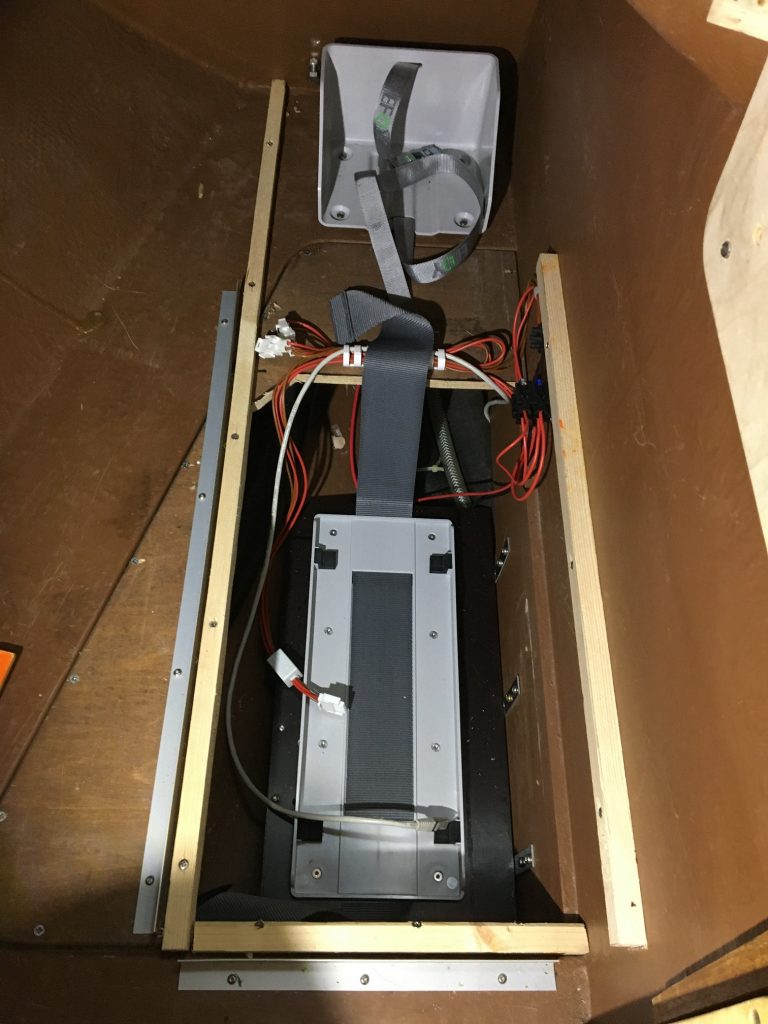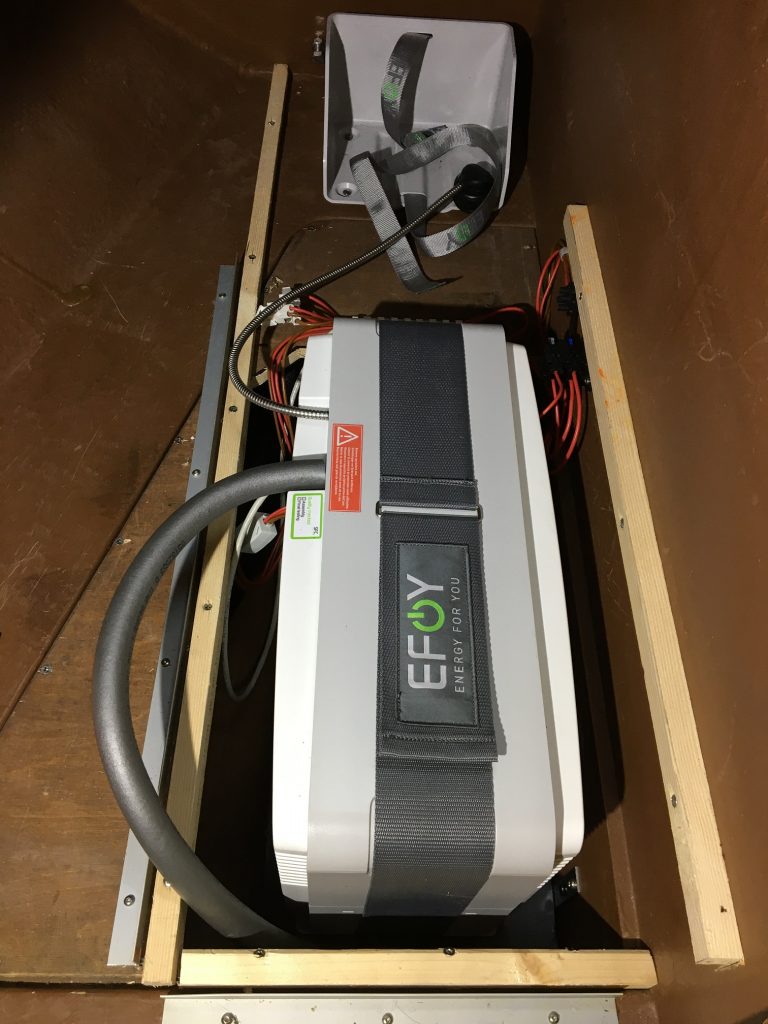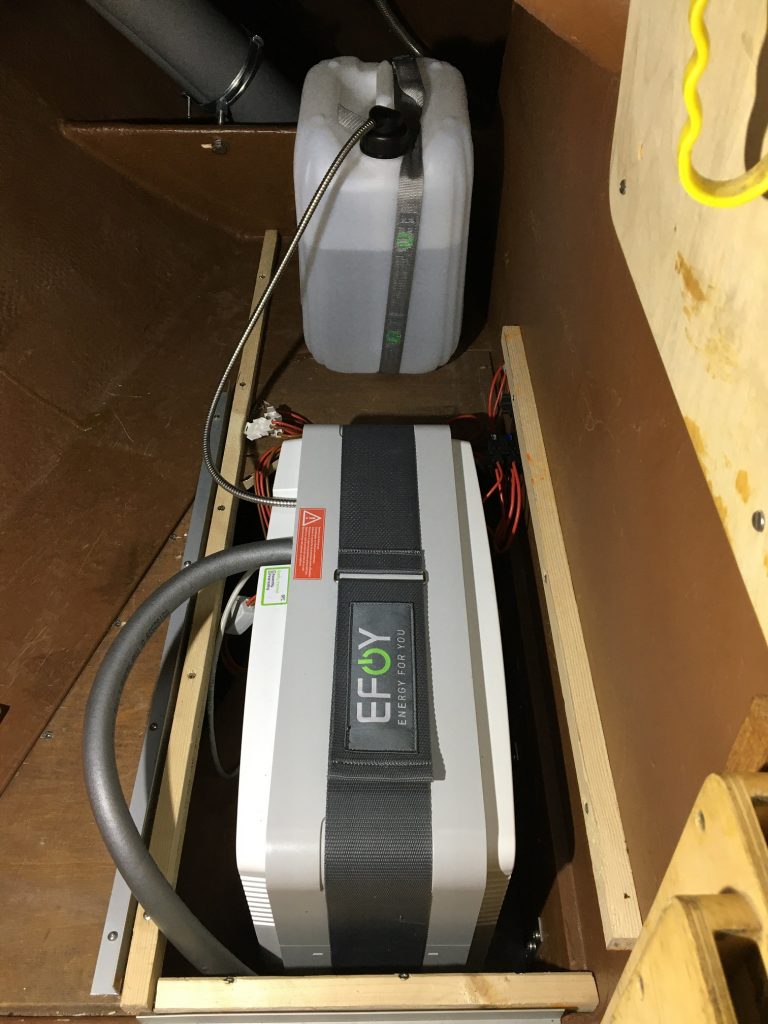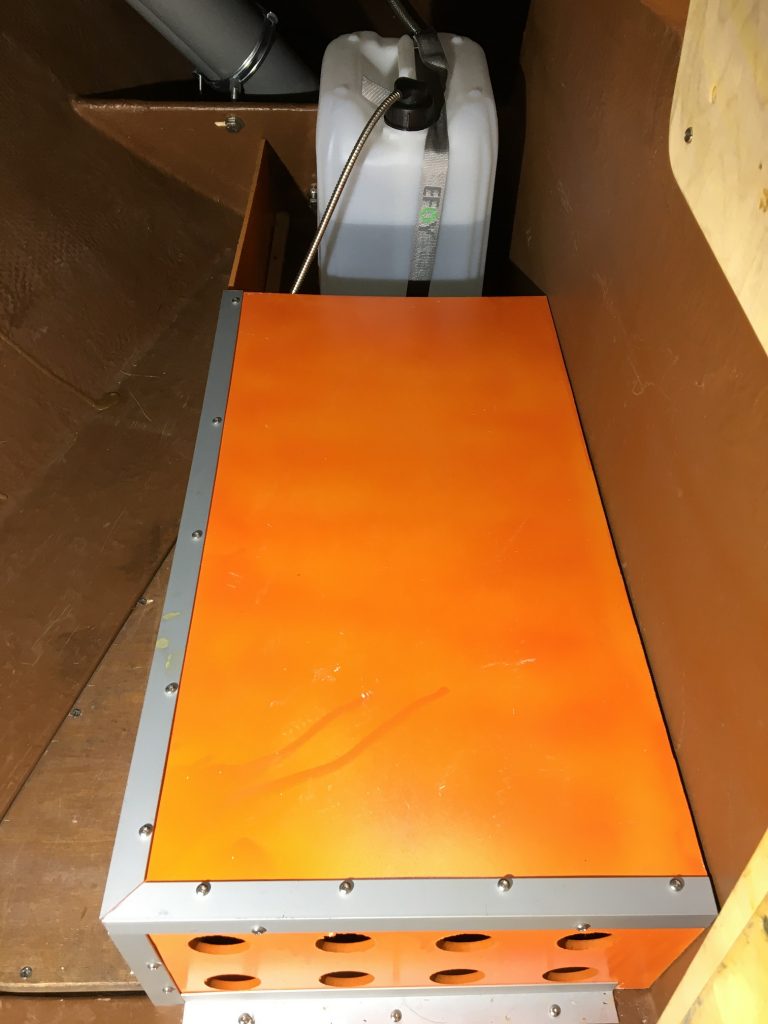We have been using an Efoy Comfort 140 fuel cell to supplement the charging power on our 39 foot sailing yacht since early 2019. Below are the technical features:
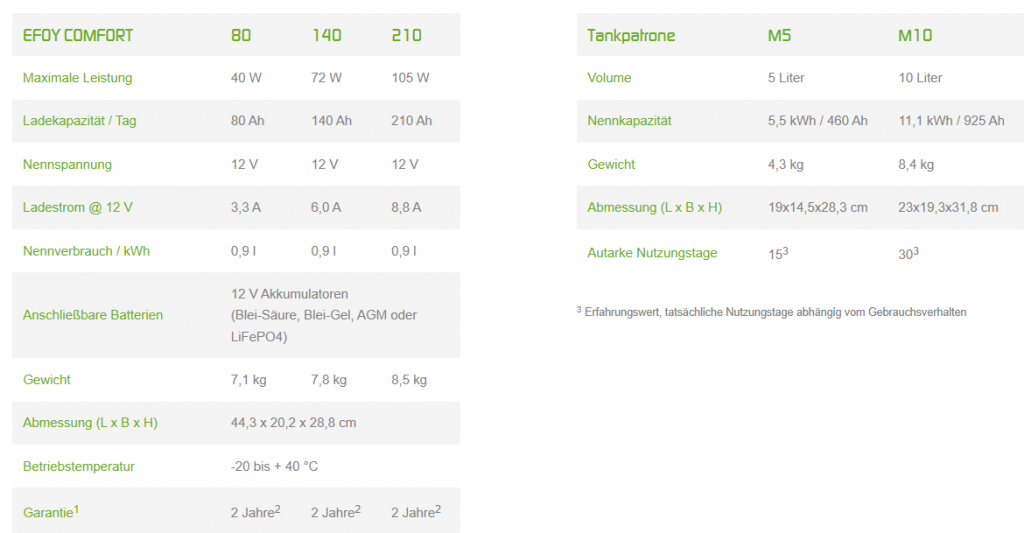
In Spiegel Online on 04.03.2020 I read an interview with Roland Gumpert, who describes quite clearly the functional principle of methanol as an energy carrier for the fuel cell:
SPIEGEL: Warum gerade Methanol?
Gumpert: Methanol ist der simpelste Träger für Wasserstoff. Er ist hier an ein Kohlenstoffatom und ein Sauerstoffatom gebunden, die chemische Formel von Methanol ist CH3OH. Das Methanol wird dann im Wagen auf rund 300 Grad Celsius erhitzt, ein Katalysator spaltet das Methanol dann in Wasserstoff, Kohlenstoff und Sauerstoff. Kohlenstoff und Sauerstoff scheiden wir als CO2 in die Luft aus, der Wasserstoff erzeugt den für den Antrieb nötigen Strom.
SPIEGEL: Im Gegensatz zu einem reinen Wasserstoffauto stößt der Wagen dadurch aber CO2 aus – ist so ein Auto wirklich umweltfreundlich?
Gumpert: Wir verwenden ausschließlich grünes Methanol, das zum Beispiel in der Holzindustrie mithilfe von grünem Strom gewonnen wird. Dabei wird Wasser in Wasserstoff und Sauerstoff zerlegt und dann mit Kohlendioxid, das zum Beispiel bei der Papierherstellung entsteht, zu Methanol umgewandelt. Dadurch ist der Treibstoff CO2-neutral. Wir garantieren, dass unsere deutschen Kunden grünes Methanol bekommen.
…..
SPIEGEL: Methanol verbrennt bei Sonnenlicht unsichtbar. Ist das nicht ein großes Sicherheitsrisiko?
Gumpert: Methanol ist deutlich weniger gefährlich als Benzin. Es verbrennt mit einer blauen Flamme, die bei hellem Licht schwer sichtbar sein kann, ist aber deutlich schwerer entflammbar als Benzin. Auch die Explosionsgefahr ist deutlich geringer. Außerdem ist Methanol nicht gefährlich für die Umwelt, wenn es verschüttet wird, und es kann mit Wasser gelöscht werden. Als Kraftstoff ist Methanol fossilen Treibstoffen überlegen, auch für Flugzeuge oder Schiffe.
…..
Back to the EFOY fuel cell: it was installed in a very low-lying area that had previously housed the old starter battery.
Here, both the dissipation of waste heat and the exhaust gas hose including small amounts of condensation water could be set up without any problems. This now reads/sounds worse than it is: waste heat temperature and waste gas quantities are minor or completely unproblematic. Wording installation manual:
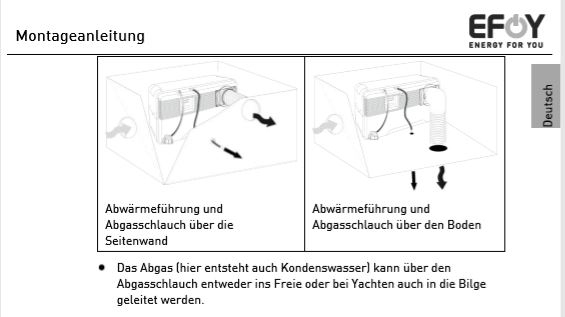
In automatic mode, the fuel cell switches on automatically when the voltage of the consumer battery falls below an adjustable limit (default setting 12.3 V). However, it can also be switched on and off manually via the remote control.
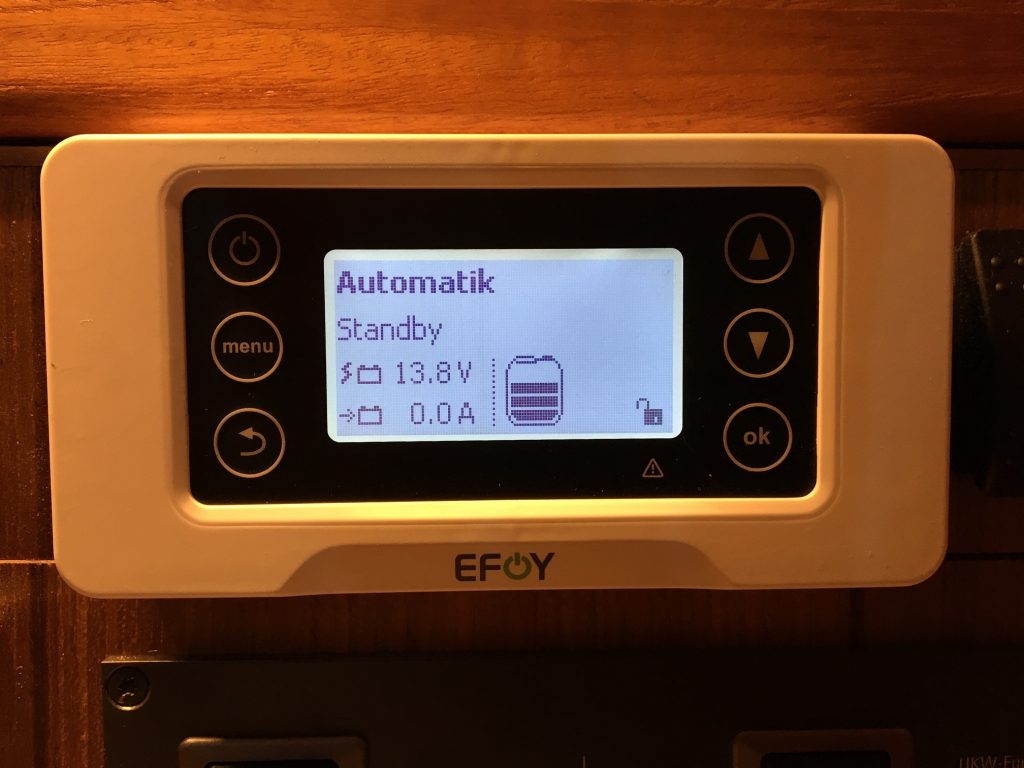
It is operated on the basis of methanol, which is supplied in 5 or 10 l fuel cartridges. The 10 l fuel cartridge costs approx. 45 € in the specialized trade.
We used a 10 l cartridge in 5 weeks Sassnitz – Stockholm – Sassnitz during our last vacation, mainly to cover some longer stretches without an overnight stay in port, some days in anchor bays and some weeks of charge state maintenance in a total of 6 weeks of layovers without shore power in Sweden. During this time, the fuel cell has run a total of between 160 h and 180 h, delivering an average of just over 5 amps of charging current.
positive:
quiet, absolutely easy to handle, works fully automatically in the background, comfortable remote control with level indicator for the cartridges. Change of cartridges very easy and safe to handle. Setting option for adaptation to individual operating requirements via remote control, e.g. threshold values for switching on and off.
negative:
expensive both to purchase and to consume. The device requires the cartridge to be changed before it is really empty. There remains a residue of just under 10% in the cartridge, which also cannot be decanted to refill another cartridge. As far as I know, there is also no return system for the emptied cartridges.
Correction on 14.10.2020: The cartridges are actually completely emptied. Only if you sail with heeling while the fill level is running low, there remains a natural rest 😉 … If the ship then later is not heeling anymore, you can restart the device and the canister is then completely emptied. Sorry, was my mistake.
Conclusion:
The aim is to be able to spend several days at anchor when cruising without having to constantly check the charge level of the consumer battery. The solution should be comfortable and unobtrusive and also be able to withstand rough sailing. I did not want to have complex technology on deck for the extraction of wind or solar energy or a heavy generator. Measured against these requirements, I am very satisfied and can only recommend the solution for similar requirements.
-
Recent Posts
Recent Comments
- Calypsoskipper on Expose Finngulf 39
- Christian on Expose Finngulf 39
- Calypsoskipper on Expose Finngulf 39
- Kenneth Melcher on Expose Finngulf 39
- alex on Saildrive diaphragm – replace according to instructions or just keep?
Kalender
January 2026 M T W T F S S 1 2 3 4 5 6 7 8 9 10 11 12 13 14 15 16 17 18 19 20 21 22 23 24 25 26 27 28 29 30 31 Tags
12 V Verkabelung 12 V wiring Anchor windlass Ankerwinde Biscaya Bora Segel Bretagne Brittany Camaret sur mer circuit distribution Cornwall Cowes Cuxhaven Den Helder Diaphragm English Channel Falkenberg falkenbergs Båtsällskap Falmouth Gezeitensegeln havarie Hydrogenerator Lewmar Ocean Membrane MiniPlex-3USB-N2K Nordsee Norwegen Oxley Parasailor Plymouth Ramsgate Saildrive Saildrive diaphragm Saildrive Membrane SailingGen Seenotrettung Segeln in Tidengewässern Sjöräddnings Sällskapet Skagen Skagerak Stromkreisverteilung tidal navigation tidal water routing Tidennavigation ÄrmelkanalArchiv
Kategorien

